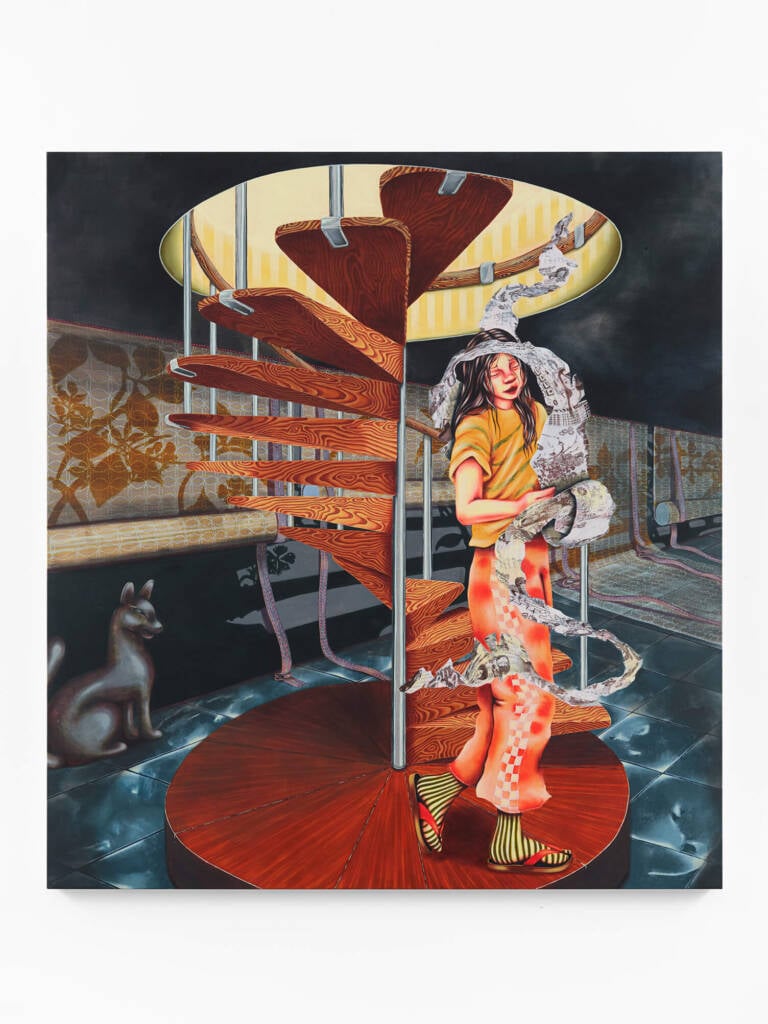For many painters, the magic happens in the distortion, the taking of daily life and bending it into something stranger, more magnetic. Zoé Blue M. does just that. Her paintings slip between bathhouses with ping-pong tables at their core, and tattooed spirits whose hair gleams pink against the dark. They feel like fragments of a memory you’re trying to hold onto, half-remembered, half-invented—works in which cultural hybridity becomes both subject and method, a way of recombining references until they feel uncanny yet inevitable.
These worlds arrive to her in flashes, and she builds around them, layering the ordinary with something off-kilter. Following her recent show at Jeffrey Deitch art gallery and her ongoing exploration of cultural hybridity, Blue M. talks with hube on loud gallery openings, the satisfying clack of Mahjong tiles, and the parallel life she imagined for herself if painting had never taken over.
hube: You were born in France but are Japanese-American. In what ways does your sense of place, heritage, or cultural hybridity influence your creative process and the stories you choose to tell?
Zoé Blue M.: I was born in Toulon, France to a Japanese-American mother and a Marseillais father. La Provence and Los Angeles both run through my blood in equal measure. I don’t try to consider each part as categorically separate entity of myself since both are deeply mixed together through my upbringing and my visual landscapes. Japan and France have a rich and complicated history of mutual appreciation, influencing each other through painting, fashion, and food. When I add in my own personal ingredient of the Japanese-American experience on the West Coast, I end up with a plethora of information to dance through. My cultural hybridity is a natural stepping stone for me into my paintings, history and folklore being the place I really like to reside; and it’s not just written history, but also that of brush marks, patterns, design, film — you name it.
h: Having studied at both RISD and UCLA, how did those different contexts shape your artistic voice? Were there unexpected lessons you carried from each into your practice today?
ZBM: Both of my schooling experiences were hugely influential to how I make! I would even say I was shaped through experiences far before that. My mother encouraged me from a young age to be myself in the most creative ways possible. I had a teacher in high school who let me sit around crying and drawing as a young sad teen. Every step of the way I was shown that I could at least make something. It took me a few years of painting in my studio apartment with three friends before I decided to go to RISD which threw my work ethic into overdrive. I loved it there, it was tough, and I got to be the craziest version of myself. The ultimate lesson that I got out of that experience was that if you think of something you want to make, against all odds and no matter how hard, you can almost always pull it off. UCLA came soon after that, and the pace was slower and more intentional. It was, like all experiences, what you make of it. My mentors at UCLA were phenomenal, each pushed me in a different way resulting in fantastic shifts in my mode of making. I walked away from there knowing to never (ever!) stop pushing, learning to shift my ways of thinking/making, questioning simple things like “why do I always do that stroke in that way?”

Double Shot, 2025

Lunacy: Unrolling Letters, 2024

